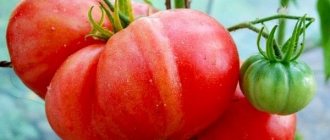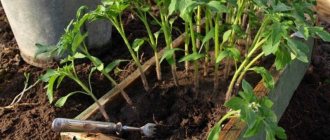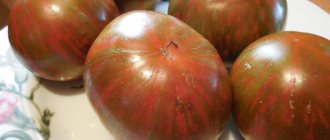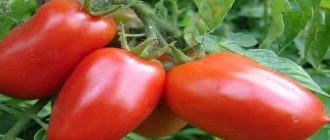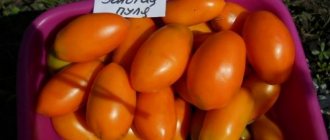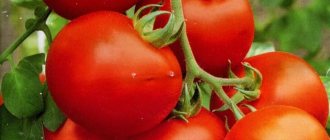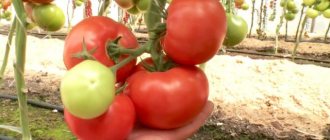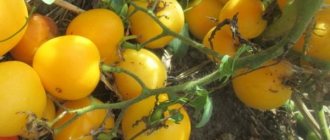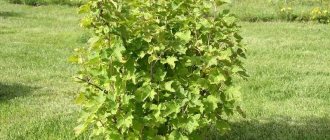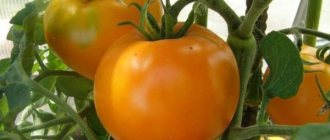The Demidovskie Lapti tomato is perfect for regions with risky farming conditions. It will surprise you with its stability, endurance, and easy cultivation.
| Height | Landing location | Ripening time | Fruit color | Fruit size | Origin | Fruit shape |
| Medium height | Greenhouse, Open ground | Mid-season | Pink | Large | Variety | Flat-round |
Description of the variety: so big, just a “bast shoe”
The height of the bush varies from 130 to 180 cm. The foliage is dark green and not very dense. The variety is mid-season, the period from germination to technical maturity is 110–115 days, intended for cultivation in protected and open ground conditions.
Ripe fruits are dark pink, have a rounded-flat shape, indeed reminiscent of bast shoes, and have “fleshy” pulp and excellent taste.
The weight of one fruit is 400-500 g. If agricultural technology is fully followed, the yield reaches 5-6 kg per 1 m². In central Russia and in the northern regions, tomatoes of this variety are best grown indoors.
“Demidov bast shoes” are great for:
- salads;
- It is convenient to make tomato juice from them;
- small fruits are suitable for seaming.
Tomatoes of this variety produce a surprisingly tender lecho. Tomatoes have good shelf life and do not lose their consumer qualities for up to 10 days.
Even though it’s a bast shoe, it’s good for everyone!
Yes, despite this name (and many people know that bast is the name given to a person who is unlucky in some way), this variety of tomato will surprise everyone. It is unpretentious, bears fruit well in the conditions of Siberia, the Urals and other “difficult” regions, and is characterized by good yield.
The bush at Demidovsky bast shoes is of medium height, reaching approximately 130-180 cm. The foliage is average, the leaves are dark green. The tomato is a mid-season variety; the approximate time from germination to the ripening of the first tomatoes is 110-115 days.
It is grown in greenhouses, in shelters under arcs with film or non-woven material, as well as in the open air.
The fruits are round-flat, very similar in appearance to bast shoes or boats, and have a rich dark pink color. At the ripening stage they are orange-red. Tomatoes are distinguished by very fleshy and juicy pulp, excellent sweet taste.
On average, the weight of the fruit is about 400-500 grams. The variety is productive, yielding up to 5-6 kg per bush, but subject to proper agricultural practices. In the conditions of the middle zone, as well as the northern regions, in Siberia and the Urals, cultivation in greenhouses is recommended.
Tomatoes are suitable for:
- fresh consumption;
- preparation of juices, sauces, purees.
The fruits make an excellent tasty lecho; small fruits can be preserved.
After harvesting in a state of blanche ripeness, it ripens well indoors. Thanks to its thick skin, it lasts well for up to 10 days without losing its appearance or taste.
Why are Demidovskie Lapti good?
In the Siberian climate, growing large, juicy tomatoes is far from easy. The breeders of this variety have done everything to make this difficult task easier. This variety has proven itself well and has already become a favorite of many gardeners and summer residents who have chosen it.
The Demidovskie bast shoes variety compares favorably:
- disease resistance;
- high productivity;
- not afraid of temperature fluctuations;
- excellent taste and appearance of the fruit.
If the timing of planting seedlings is observed, tomatoes of this variety have time to fully grow and ripen during the short summer of the northern regions before late blight occurs. Seeds of ripened tomatoes can be used for sowing next year. There were no serious complaints from gardeners regarding the “Demidov Bast Shoes”. The variety is very resilient and unpretentious, but compliance with certain rules when growing is still necessary.
Tomato Demidov - description of the variety with photos
This variety appeared recently - it was bred by breeders from Barnaul at the end of the last century. After testing, the Demidov tomato was included in the State Register of Russia in 2001. This tomato is recommended for growing in open ground and is unpretentious to growing conditions. Therefore, even novice vegetable growers can plant it.
The Demidov tomato tolerates temperature changes well and grows well even with a sharp drop in temperature, since during this period the low bushes receive heat from the heated soil.
The bushes are quite compact, the number of side shoots is average. The shoots are erect, medium leafy, and can reach a height of 0.60-0.65 m.
The foliage is medium in size, not typical for tomato plants, more similar to potato plants, quite wide, color - dark emerald. Wide leaves save the ovaries from excess moisture in the air during rains and fogs.
The bushes do not require shaping, tying to supports or removing stepsons. The first inflorescences appear after 6-7 permanent leaves, the next ovaries are formed through a pair of true leaves.
Ripe fruits are round, slightly flattened; sometimes there may be slight ribbing at the base of the tomatoes. The skin is dense, even, smooth, not prone to cracking. Its color is crimson with a pinkish tint. The pulp is quite fleshy, inside there are 4-5 seed chambers with an average amount of seed material.
The weight of ripe tomatoes is up to 180-200 g. The taste of the fruit is good. Ripe tomatoes have an excellent presentation. The harvested crop can withstand transportation well over long distances.
This variety is resistant to changes in weather conditions, short-term drops in temperature, and to most diseases to which many vegetable crops from the nightshade family are susceptible.
Pros and cons of the variety
The main advantages of the Demidov tomato are:
- good yield - up to 11 kg per square, subject to the rules of growing and caring for tomatoes;
- good presentation of the harvested crop;
- large size of ripe tomatoes;
- wonderful taste of tomatoes;
- bushes do not require formation, tying and removal of stepsons;
- even when weather conditions change, the ovaries continue to actively form.
There are practically no disadvantages noted in this variety.
Productivity
In regions with a short summer period, this variety is best grown in seedlings. Seeds for seedlings need to be sown a couple of months before transplanting the grown seedlings to a permanent place.
Picking of thickened seedlings should be done at the stage of appearance of two true leaves. Seedlings should be watered regularly as the topsoil dries out. Also, while growing seedlings at home, they need to be fed at least twice.
The first feeding is carried out 12-14 days after the picking procedure. The next one is two weeks after the first one. Such fertilizers should contain ammophoska. You can also feed young plants with a solution of mullein or chicken manure, but such organic matter must be diluted in a ratio of 1:10 so as not to burn the delicate root system of these vegetable plants.
It is better to prepare the beds for these tomatoes in advance - in the fall. For autumn digging, humus, rotted manure or compost are added to the soil - 10 kg per square. In the spring, the soil is dug up again, breaking up clods of earth, while at the same time introducing complex mineral fertilizers into the beds.
Tomato Demidov, grown according to the “plant and forget” principle - video
During its existence, the mid-season tomato variety Demidov has already gained popularity among summer residents living in Siberia and other regions with similar climatic conditions due to its resistance to changes in weather conditions, the formation of ovaries even during cold spells and high yields.
Seeds should be prepared for sowing
Preparing seed material is an important part of the work. Under no circumstances should it be neglected. The quality of future seedlings, and subsequently the harvest, largely depends on this. Tomato seeds should be pickled in a weak, slightly pinkish solution of potassium permanganate, which will protect them even more reliably from diseases, and then rinsed and allowed to dry. The second step is treatment with a growth stimulator.
For this purpose they usually choose:
- Epin;
- Ideal;
- Zircon;
- wood ash.
Each growth stimulator comes with instructions that must be strictly followed, and if you decide to use wood ash, do this: mix a tablespoon of wood ash in a liter of water. After being treated with growth stimulants or ash, the seeds are germinated in a moistened canvas fabric or in a paper napkin until they hatch.
As soon as this happens, the seeds are sown in pre-prepared containers with soil. Tomatoes prefer a sifted, lump-free mixture of turf soil and river sand, with the addition of ash and superphosphate. However, it is more convenient to buy ready-made soil.
The seeds are sown in shallow furrows, which are then carefully sprinkled with soil, lightly watered and covered with either glass or cellophane to retain moisture. The temperature before emergence should be kept within +23 °C - + 24 °C. As soon as the seedlings appear, the glass is removed and the containers with the seedlings are exposed to light, trying to keep the temperature no higher than +18 °C for a week. After a week, it will be possible to increase it to +20 °C, avoiding sharp fluctuations.
Tall tomatoes for the greenhouse
I definitely plant the listed varieties, but there are also some that I just liked, and I periodically grow them in the greenhouse, but I have not become a fan of them. Of the indeterminates, I like the raceme varieties the most. Again, this is primarily because they look beautiful on the bush. There are only three varieties, and each has a special reason to grow it.
“Intuition F1” is a mid-season hybrid, but I would classify it as a late-season hybrid. Not only does it reach harvest ripeness only by mid-August, but biological maturity also comes quite late. Some specimens of these tomatoes ripen even until the end of October. But, on the other hand, this is convenient because as a result, we have our own fresh tomatoes at home for a very long time. That's why I sow it in February.
Rice. 12. Photo from the end of July, but the fruits have not yet begun to ripen.
But “Intuition F1” is very easy. This hybrid is great for freezing for future use. In winter, I make pizza and frittata with them, as they do not defrost like porridge, but retain their meatiness well when cut.
Rice. 13. The fruits are all smooth and beautiful.
Rice. 14. In this form, I send “Intuition F1” to deep freeze.
“Scarlet Candles” is a cluster variety, mid-season. They don’t have a special taste, but what a shape! Looks impressive in preparations with cucumbers. However, this is why I grow them. It’s nice to admire such a jar later in the winter.
Rice. 15. The length of “Scarlet Candles” is almost like pickling cucumbers.
Rice. 16. “Scarlet candles” look neat, they all have a characteristic “spout”.
“De Barao” is quite late-ripening; I sow it earlier than the bulk of tomatoes. I really like it in preparations, it does not crack and is very tasty, both fresh and pickled.
Rice. 17. "De Barao" is resistant to disease. I always plant it on the north side, tying it above the entrance to the greenhouse, because it is very tall, and the upper tier ripens even in the last ten days of August, despite the first cold nights.
Rice. 18. The fruits are beautiful, all as one.
I have tried a great variety of salad varieties, I still want to find the most delicious one. Of the unusually colored tomatoes, I really like the taste of Malachite Box and Black Prince . Both are tall and require pinching, gartering, and formation into 1-2 stems, but the effort is worth it, the fruits are magnificent. “Black Prince” is dark burgundy when fully ripe.
Rice. 19. “Malachite box” in biological maturity – green.
Rice. 20. All these “Malachite Box” tomatoes are already ripe, although in appearance they seem unripe.
The yellow giants are not inferior in taste, of which the most fleshy and tasty for me are “Yellow Truffle” - of an unusual shape, “Persimmon” - indeed, the pulp is cut like the fruit of the same name, “Golden King” and sweet as a melon, “ Golden Bull" . “Golden Heart” and “Altai Yellow” were less impressive But it should be noted that the shelf life of yellow tomatoes is inferior to red ones. From salad reds, I grew “King of Large”, “Cardinal”, “Canary”, “Bear’s Paw”, “Mazarin”, “Altai Red” . What can I say about them - they are all equal, as if they were selected. It tires them to constantly tug and tie them up. One good thing is that they are large.
Rice. 21. Everyone looks the same on the bush. This is Cardinal.
Rice. 22. “Cardinal” is well kept.
Rice. 24. In the foreground is “Mazarin”. It differs only in shape, in taste - like all other red-fruited ones.
Rice. 25. “Altai Reds”, however, can be praised for their friendly maturation.
Separately, I would like to mention the pink-fruited tomatoes “Miracle of the Earth”. If you are lucky with the summer and it is not very hot, then you can get a good harvest from this variety.
Rice. 26. “Miracle of the Earth” are also tall.
But, if there is not very good ventilation in the greenhouse, then this variety will give a characteristic light yellow border, I don’t like it, and I cut it off before use.
Rice. 27. “Miracle of the Earth” - on the right. They are the same size as the Red Giant on the left.
Separately, it should be said about tall cherry tomatoes, for example, “Chio-chio-san”, “Sweet Cherry F1” and others. Yes, many of them are sweet, they look elegant both in the greenhouse and in pickles, but many of them are thrown away and require careful care. No matter how much I refuse to plant them, I still “break down”, I really want to admire the brushes.
Rice. 28. “Red date” is, of course, delicious.
Rice. 29. “Goldilocks” also tastes good if you resist and don’t eat it half-ripe - and it can be eaten even half-ripe.
How to care for emerging shoots
After the emergence of seedlings, the main parameters that should be closely monitored are temperature, light, and humidity. If the days are still short and there is not enough sun, in order to avoid stretching the seedlings, they are illuminated with special lamps. If seedlings placed on a windowsill are exposed to temperature changes (for example, a draft), this can have a detrimental effect on their development. Under no circumstances should the soil be allowed to dry out, but excessive watering should also be avoided.
Usually, seedlings are picked at the third leaf stage, and this process should not be delayed, so as not to later encounter great difficulties during transplantation, when the roots of the sprouts become more powerful and intertwine with each other. Before picking, the seedlings should be watered well, and after that, they should be darkened for several days.
During growth, seedlings can be fed twice with complex fertilizer, and 10 days before planting directly into the ground, they need to be “hardened” by taking them outside or into a greenhouse for a while. Hardening begins with 15 minutes and increases the time to several hours.
On a note! The hardening process allows plants to smoothly adapt to new conditions. If this is not done, adaptation will still occur, only more slowly, for a long time and with greater risk for the plants.
Planting seedlings in the ground
Of course, each gardener determines the planting time himself, based on the climate where he lives, weather conditions and the method that will be used for growing tomatoes (in open ground or indoors). As a rule, they try to plant when the return of frost has already been ruled out and the soil has warmed up sufficiently. In greenhouses this happens earlier.
The beds should be dug up, prepared and loosened in advance. Tomatoes prefer loose, neutral, fertilized soil. Summer residents often use covering materials to prevent unpleasant surprises from unstable weather.
When planting seedlings, you need to remember that plants growing too close will lack nutrition and light and will have to waste energy competing with each other. It is optimal when no more than three plants are planted per 1 m².
Features of care
After planting the seedlings, the seedlings do not need to be watered for a week. This is done so that the plants and their root system are more actively involved in the “work” and adapt. In the future, watering is carried out in such a way as to prevent the soil from drying out, but also to avoid waterlogging and rotting of the roots.
For this purpose, the soil around the plants is mulched, which helps to retain moisture and avoid drying out. Mulching is carried out using sawdust, straw, dry grass or compost. This procedure will also slow down the growth of weeds around the tomatoes. If mulching is not used, then, at regular intervals, the soil around the plants should be loosened in order to improve air exchange in the root system.
Necessarily! When growing tomatoes indoors, you should carefully monitor the level of humidity inside the greenhouse and periodically ventilate, preventing the formation of condensation on the leaves of the plants. And in hot hours, ventilation is necessary to protect plants from overheating.
Approximate watering schedule:
- Before flowers appear, plants should be watered once every 3 days;
- during the period of active flowering of tomatoes and the formation of ovaries, they maintain the same schedule, only increasing the volume (if not enough);
- When the plants begin to bear fruit, water less frequently.
Reducing the amount of watering at this time is due to the fact that the abundance of moisture worsens the taste of tomatoes and makes their flesh more watery.
Additional fertilizing should be applied no more than 3-5 times per season. During the period of active growth of the stem and leaves, nitrogen fertilizers are used more. And just before flowering and the formation of ovaries - potassium and phosphorus. Excess nitrogen leads to overactive growth of the stem and leaves, which prevents the plant from moving to the stage of flower and ovary formation.
For this reason, many people use foliar feeding on foliage, using ash solutions or solutions with whey or iodine and boric acid for this purpose.
In order for the ovaries to be good and numerous you need:
- ensure that the temperature in the greenhouse does not exceed + 30 °C, otherwise the pollen will become sterile;
- plant several honey plants next to the tomatoes to attract bees;
- In the morning, gently shake the brushes with flowers so that the pollen falls off, or you can use a brush for painting.
There are some other “tricks” that can improve your harvest. For example, many gardeners tear off the lower leaves on the main cluster with flowers, and do the same with the foliage that obscures the fruits so that sunlight can penetrate unhindered.
Demidov bast shoes are recommended to be grown in “two stems”. By forming a plant bush in this way, the best result is achieved. For this purpose, the strongest stepson is left under the main brush with flowers, and all others are cut off at a height of 1.5 cm from the ground. Pruning should be done in the morning so that the “stumps” dry out during the day.
Having decided to form a bush into one stem, you need to remove all the side shoots. In the first ten days of August, the stem of the plant is pinched. The point of this procedure is that in the remaining summer days, the tomato stops growing and begins to devote all its energy to the ripening fruits.
Proper agricultural technology is the key to plant health:
- you need to take the preparation of seeds seriously, treat them and adhere to sowing dates;
- Soil rotation should be carried out, avoiding growing the same crop in the same place from year to year;
- you need to adhere to the recommended planting schemes;
- You should monitor the ventilation of greenhouses, watering and fertilizing of plants.
There are many folk, proven methods to keep plants healthy. For example, spraying them with various solutions prepared independently.
From late blight:
- Tomato bushes, before flowers appear, are treated with garlic solution and solutions to which such agents as Barrier, Barrier, etc. are added;
- When the first signs are detected, use the drug Oxychom.
To combat blossom end rot:
- tomato bushes are treated with calcium nitrate dissolved in water;
- monitor the regularity of watering and do not allow the soil to dry out.
This variety of tomatoes is resilient and resistant to diseases, but prevention will not hurt. With proper care, the fruiting of "Demidov's bast shoes" will be excellent.
They harvest fruits without waiting for them to be 100% ripe on the plant's trusses. Firstly, it is not always possible to catch such a moment in time and it is rarely “massive”, and secondly, Demidov’s bast shoes themselves will perfectly “reach” the desired condition if you take them off when they are slightly pink. With this approach, the overall speed of fruit ripening increases.
Having decided to plant this variety of tomatoes again next year, you should leave one of the best fruits on the bush “for seeds”, which has no flaws, and it fully corresponds to the characteristics declared by the breeders.
Harvesting giant fruits with tomato Demidovskie bast shoes - detailed description of the variety
The Demidovskie Lapti tomato is perfect for regions with risky farming conditions. It will surprise you with its stability, endurance, and easy cultivation.
| Height | Landing location | Ripening time | Fruit color | Fruit size | Origin | Fruit shape |
| Medium height | Greenhouse, Open ground | Mid-season | Pink | Large | Variety | Flat-round |
Description and characteristics of the variety
The Demidovskie bast shoes tomato is intended for film shelters and planting in open beds. It is grown:
- in Siberia;
- in the Urals;
- Central regions;
- in the northern regions.
It is a medium-growing determinate variety. The bushes grow up to 130 cm, the shoots are strong and powerful. The foliage and bushiness are moderate.
Ripening time is average - 115-122 days from germination.
Fruit characteristics:
- deep pink color;
- the pulp is fleshy, sugary;
- flat-round shape;
- the skin is strong;
- juiciness is moderate;
- the taste harmoniously combines sweetness with sourness.
The average weight varies in the range of 400-500 g.
Tomatoes are used for fresh salads and slices. Juices, pastes, ketchups, as well as preparations such as adjika and lecho are prepared from them.
Advantages and disadvantages
Pros:
- excellent yield;
- large fruit;
- good tolerance to cold weather;
- drought tolerance;
- disease resistance;
- marketable condition.
Minuses:
- the need for feeding and garter.
Productivity
From 1 m2 they harvest 14-16 kg, from 1 bush the harvest is 5-6 kg.
Features of cultivation and storage
Seeds are sown in the 1st-2nd decade of March. Before sowing, simple manipulations are carried out:
- immersed in saline solution to select the best seed;
- soaked in 1% potassium permanganate for disinfection;
- treated for 12 hours with “Epin” or “Zircon” to increase germination.
For seedlings, loose, fertile soil is prepared and mixed with turf, compost and sand.
The seeds are planted to a depth of 1.5 cm and sprinkled with peat. The boxes are placed in a warm place with a temperature of 22-24 degrees. Cover the top with glass until germination.
How to grow seedlings:
- harden for 1 week at 15 degrees;
- feed with Kemira-universal once every 10 days;
- dive with 3 true leaves.
Planting and care
Seedlings are ready for transplanting at the age of 50-60 days. In harsh climates, they are planted in beds in early June, when the temperature is not lower than 16 degrees.
It is advisable to fertilize the beds; per 1 m2 the following is applied:
- compost 4-5 kg;
- superphosphate 30 g;
- wood ash 1 cup.
Place 3-4 bushes per 1 m2, the optimal distance between holes is 50 cm.
Features of care:
- water moderately, avoiding waterlogging;
- mulch with straw or mowed green manure;
- feed 1-2 times a month.
Diseases and pests
The variety has good immunity to many infections:
- VTM;
- cladosporiosis;
- fusarium.
Prevention against fungal pathogens is carried out:
- irrigate with copper preparations;
- do not allow thickening;
- ventilate greenhouses.
Of the pests, attention is paid to the invasion of aphids and thrips. “Aktofit” or “Decis” is used against insects. Whiteflies and cutworms can cause damage to tomatoes. For fighting, the bushes are irrigated with “Profi” or “Karate”.
The Demidovskie Lapti tomato will especially appeal to connoisseurs of giant tomatoes with pink, fleshy flesh. Good harvests of this variety are consistently pleasing, regardless of weather changes.
Source: https://repka.online/ovoshhi/tomaty/srednespelyie/demidovskie-lapti.html
